Comprehensive Business Environment Analysis Report: Unilever
VerifiedAdded on 2022/12/23
|18
|4860
|45
Report
AI Summary
This report provides a comprehensive analysis of Unilever's business environment, examining its organizational structure, which is identified as a divisional structure. It delves into the importance of accounting for business success, presenting key accounting information through a Profit & Loss (P&L) account. The report also explores team development stages, motivational theories, and leadership styles. Furthermore, it outlines the functions of the HR department and the features of employment legislation. The impact of customer service and the benefits of customer profiling on business success are also discussed. The report incorporates PESTLE analysis to assess the political, economic, social, technological, legal, and environmental factors affecting Unilever. Finally, it provides an overview of different types of organizations in public and private sectors, with relevant examples, and the impact of the local, national, and global economic environment on the named business.
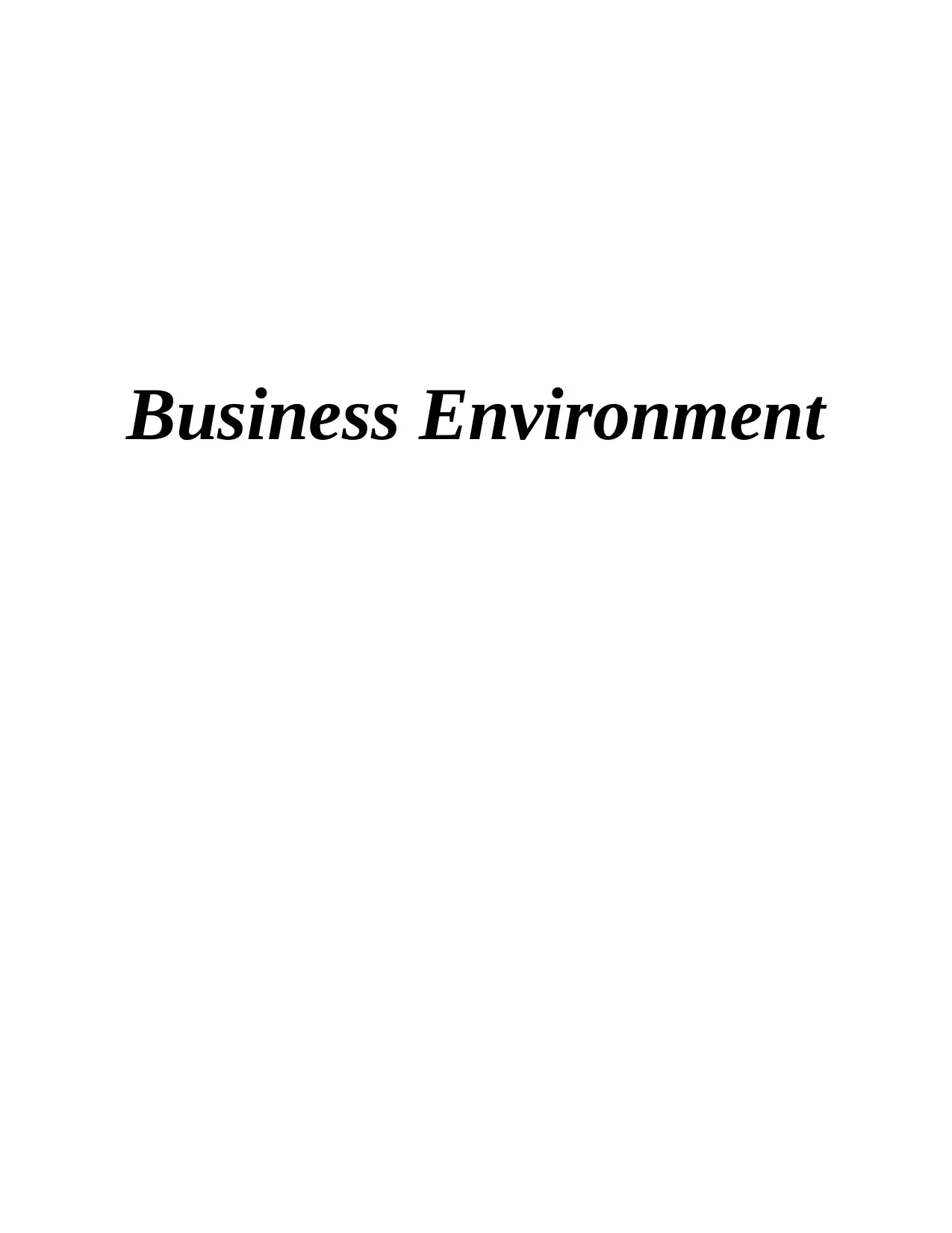
Business Environment
Paraphrase This Document
Need a fresh take? Get an instant paraphrase of this document with our AI Paraphraser
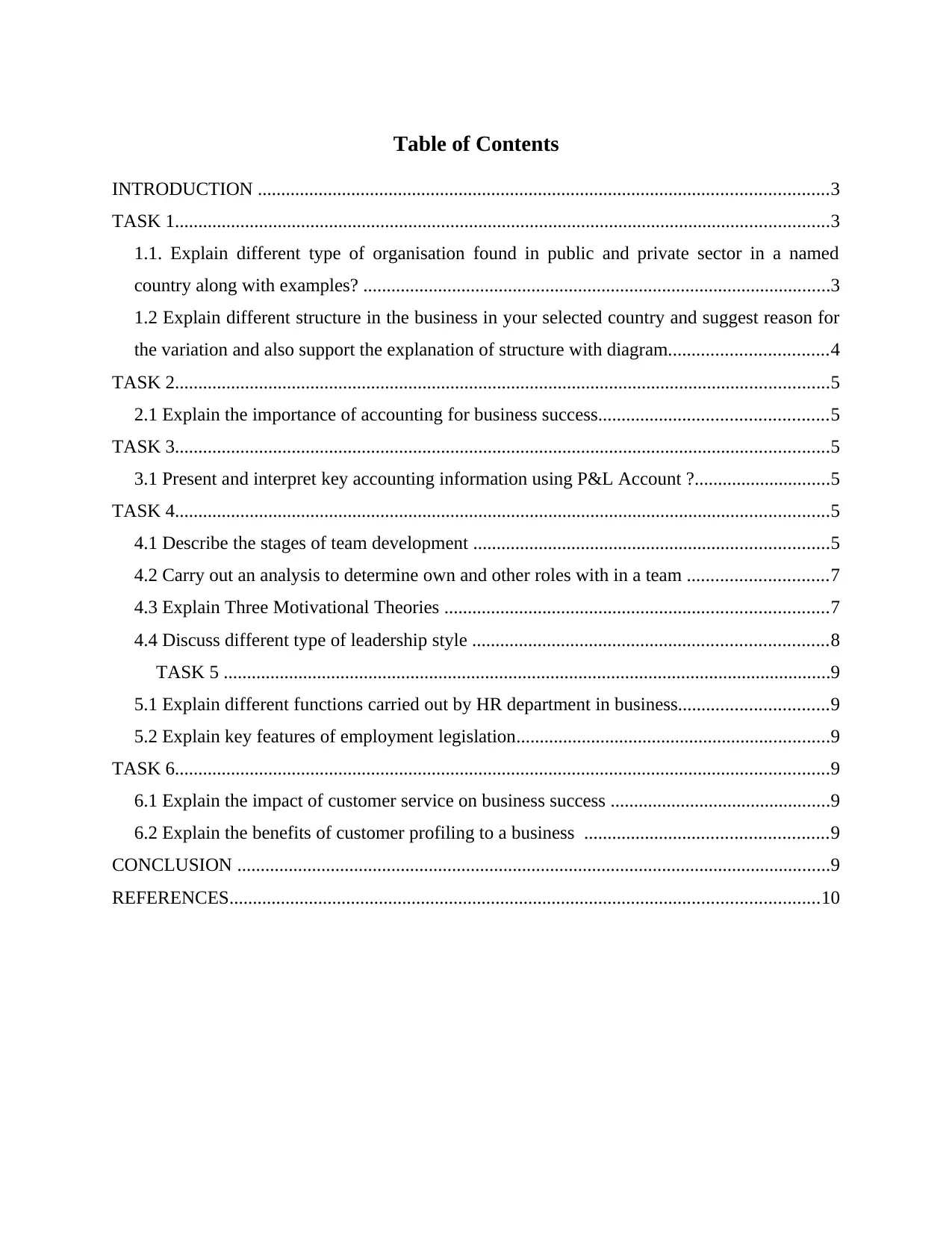
Table of Contents
INTRODUCTION ..........................................................................................................................3
TASK 1............................................................................................................................................3
1.1. Explain different type of organisation found in public and private sector in a named
country along with examples? ....................................................................................................3
1.2 Explain different structure in the business in your selected country and suggest reason for
the variation and also support the explanation of structure with diagram..................................4
TASK 2............................................................................................................................................5
2.1 Explain the importance of accounting for business success.................................................5
TASK 3............................................................................................................................................5
3.1 Present and interpret key accounting information using P&L Account ?.............................5
TASK 4............................................................................................................................................5
4.1 Describe the stages of team development ............................................................................5
4.2 Carry out an analysis to determine own and other roles with in a team ..............................7
4.3 Explain Three Motivational Theories ..................................................................................7
4.4 Discuss different type of leadership style ............................................................................8
TASK 5 ..................................................................................................................................9
5.1 Explain different functions carried out by HR department in business................................9
5.2 Explain key features of employment legislation...................................................................9
TASK 6............................................................................................................................................9
6.1 Explain the impact of customer service on business success ...............................................9
6.2 Explain the benefits of customer profiling to a business ....................................................9
CONCLUSION ...............................................................................................................................9
REFERENCES..............................................................................................................................10
INTRODUCTION ..........................................................................................................................3
TASK 1............................................................................................................................................3
1.1. Explain different type of organisation found in public and private sector in a named
country along with examples? ....................................................................................................3
1.2 Explain different structure in the business in your selected country and suggest reason for
the variation and also support the explanation of structure with diagram..................................4
TASK 2............................................................................................................................................5
2.1 Explain the importance of accounting for business success.................................................5
TASK 3............................................................................................................................................5
3.1 Present and interpret key accounting information using P&L Account ?.............................5
TASK 4............................................................................................................................................5
4.1 Describe the stages of team development ............................................................................5
4.2 Carry out an analysis to determine own and other roles with in a team ..............................7
4.3 Explain Three Motivational Theories ..................................................................................7
4.4 Discuss different type of leadership style ............................................................................8
TASK 5 ..................................................................................................................................9
5.1 Explain different functions carried out by HR department in business................................9
5.2 Explain key features of employment legislation...................................................................9
TASK 6............................................................................................................................................9
6.1 Explain the impact of customer service on business success ...............................................9
6.2 Explain the benefits of customer profiling to a business ....................................................9
CONCLUSION ...............................................................................................................................9
REFERENCES..............................................................................................................................10
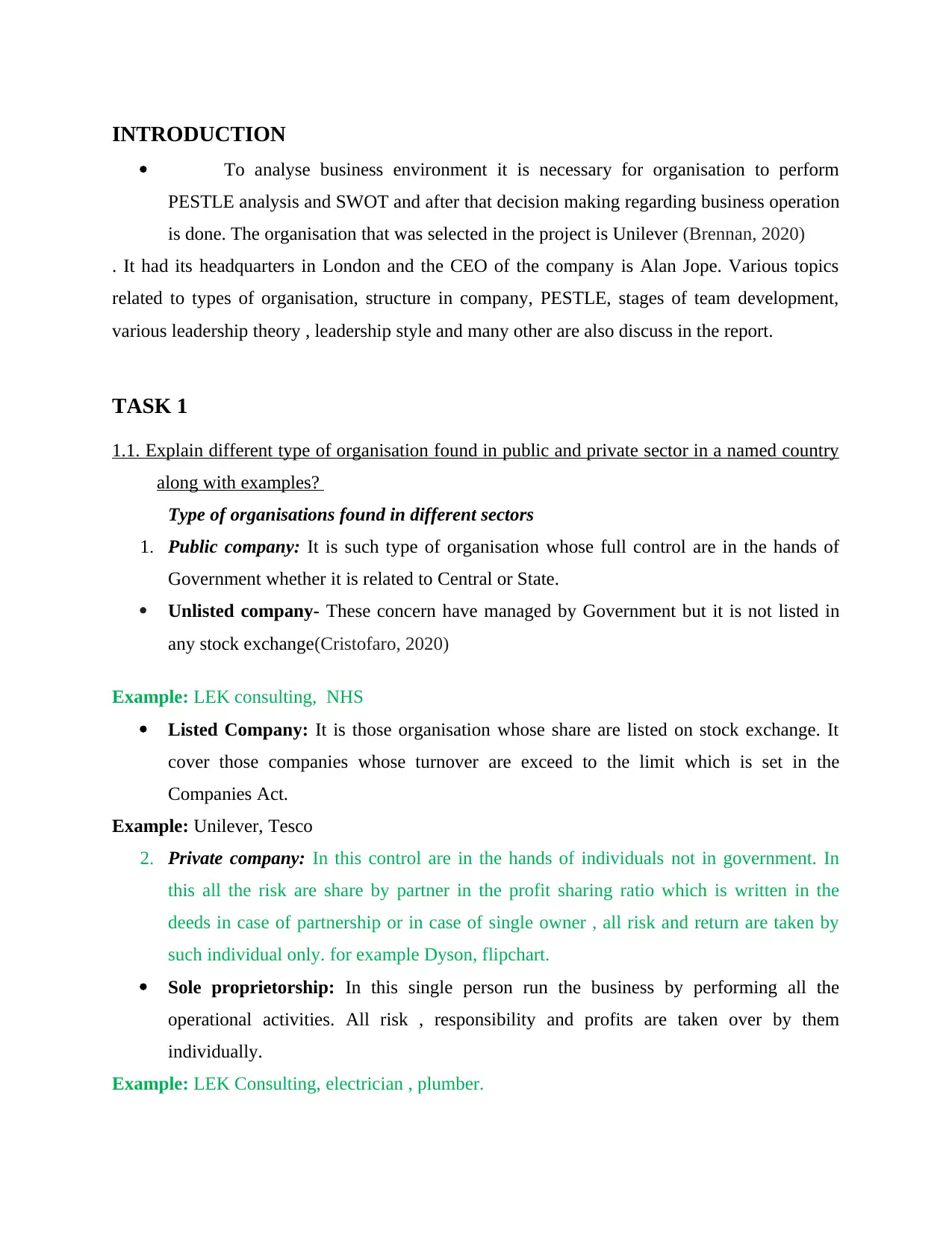
INTRODUCTION
To analyse business environment it is necessary for organisation to perform
PESTLE analysis and SWOT and after that decision making regarding business operation
is done. The organisation that was selected in the project is Unilever (Brennan, 2020)
. It had its headquarters in London and the CEO of the company is Alan Jope. Various topics
related to types of organisation, structure in company, PESTLE, stages of team development,
various leadership theory , leadership style and many other are also discuss in the report.
TASK 1
1.1. Explain different type of organisation found in public and private sector in a named country
along with examples?
Type of organisations found in different sectors
1. Public company: It is such type of organisation whose full control are in the hands of
Government whether it is related to Central or State.
Unlisted company- These concern have managed by Government but it is not listed in
any stock exchange(Cristofaro, 2020)
Example: LEK consulting, NHS
Listed Company: It is those organisation whose share are listed on stock exchange. It
cover those companies whose turnover are exceed to the limit which is set in the
Companies Act.
Example: Unilever, Tesco
2. Private company: In this control are in the hands of individuals not in government. In
this all the risk are share by partner in the profit sharing ratio which is written in the
deeds in case of partnership or in case of single owner , all risk and return are taken by
such individual only. for example Dyson, flipchart.
Sole proprietorship: In this single person run the business by performing all the
operational activities. All risk , responsibility and profits are taken over by them
individually.
Example: LEK Consulting, electrician , plumber.
To analyse business environment it is necessary for organisation to perform
PESTLE analysis and SWOT and after that decision making regarding business operation
is done. The organisation that was selected in the project is Unilever (Brennan, 2020)
. It had its headquarters in London and the CEO of the company is Alan Jope. Various topics
related to types of organisation, structure in company, PESTLE, stages of team development,
various leadership theory , leadership style and many other are also discuss in the report.
TASK 1
1.1. Explain different type of organisation found in public and private sector in a named country
along with examples?
Type of organisations found in different sectors
1. Public company: It is such type of organisation whose full control are in the hands of
Government whether it is related to Central or State.
Unlisted company- These concern have managed by Government but it is not listed in
any stock exchange(Cristofaro, 2020)
Example: LEK consulting, NHS
Listed Company: It is those organisation whose share are listed on stock exchange. It
cover those companies whose turnover are exceed to the limit which is set in the
Companies Act.
Example: Unilever, Tesco
2. Private company: In this control are in the hands of individuals not in government. In
this all the risk are share by partner in the profit sharing ratio which is written in the
deeds in case of partnership or in case of single owner , all risk and return are taken by
such individual only. for example Dyson, flipchart.
Sole proprietorship: In this single person run the business by performing all the
operational activities. All risk , responsibility and profits are taken over by them
individually.
Example: LEK Consulting, electrician , plumber.
⊘ This is a preview!⊘
Do you want full access?
Subscribe today to unlock all pages.

Trusted by 1+ million students worldwide
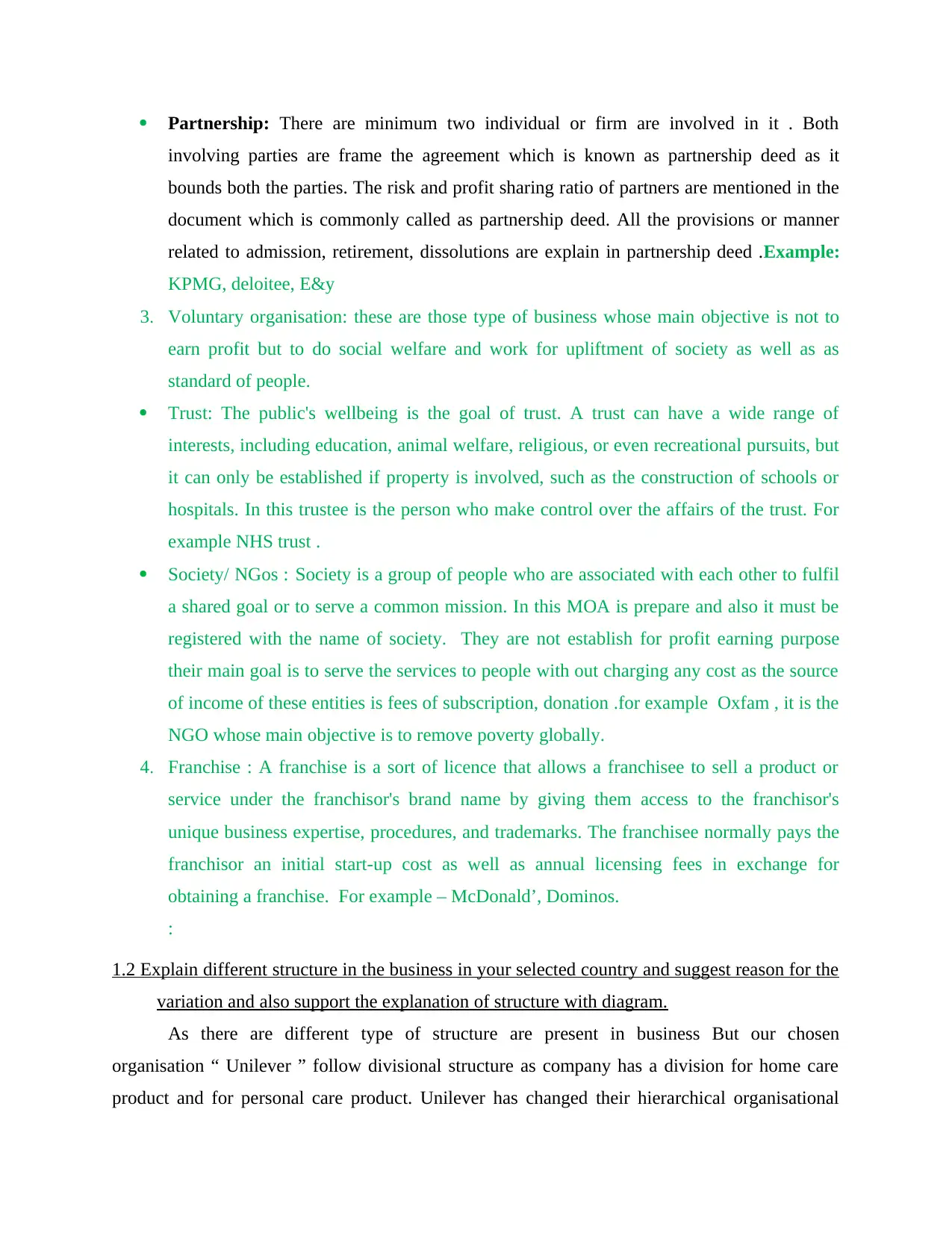
Partnership: There are minimum two individual or firm are involved in it . Both
involving parties are frame the agreement which is known as partnership deed as it
bounds both the parties. The risk and profit sharing ratio of partners are mentioned in the
document which is commonly called as partnership deed. All the provisions or manner
related to admission, retirement, dissolutions are explain in partnership deed .Example:
KPMG, deloitee, E&y
3. Voluntary organisation: these are those type of business whose main objective is not to
earn profit but to do social welfare and work for upliftment of society as well as as
standard of people.
Trust: The public's wellbeing is the goal of trust. A trust can have a wide range of
interests, including education, animal welfare, religious, or even recreational pursuits, but
it can only be established if property is involved, such as the construction of schools or
hospitals. In this trustee is the person who make control over the affairs of the trust. For
example NHS trust .
Society/ NGos : Society is a group of people who are associated with each other to fulfil
a shared goal or to serve a common mission. In this MOA is prepare and also it must be
registered with the name of society. They are not establish for profit earning purpose
their main goal is to serve the services to people with out charging any cost as the source
of income of these entities is fees of subscription, donation .for example Oxfam , it is the
NGO whose main objective is to remove poverty globally.
4. Franchise : A franchise is a sort of licence that allows a franchisee to sell a product or
service under the franchisor's brand name by giving them access to the franchisor's
unique business expertise, procedures, and trademarks. The franchisee normally pays the
franchisor an initial start-up cost as well as annual licensing fees in exchange for
obtaining a franchise. For example – McDonald’, Dominos.
:
1.2 Explain different structure in the business in your selected country and suggest reason for the
variation and also support the explanation of structure with diagram.
As there are different type of structure are present in business But our chosen
organisation “ Unilever ” follow divisional structure as company has a division for home care
product and for personal care product. Unilever has changed their hierarchical organisational
involving parties are frame the agreement which is known as partnership deed as it
bounds both the parties. The risk and profit sharing ratio of partners are mentioned in the
document which is commonly called as partnership deed. All the provisions or manner
related to admission, retirement, dissolutions are explain in partnership deed .Example:
KPMG, deloitee, E&y
3. Voluntary organisation: these are those type of business whose main objective is not to
earn profit but to do social welfare and work for upliftment of society as well as as
standard of people.
Trust: The public's wellbeing is the goal of trust. A trust can have a wide range of
interests, including education, animal welfare, religious, or even recreational pursuits, but
it can only be established if property is involved, such as the construction of schools or
hospitals. In this trustee is the person who make control over the affairs of the trust. For
example NHS trust .
Society/ NGos : Society is a group of people who are associated with each other to fulfil
a shared goal or to serve a common mission. In this MOA is prepare and also it must be
registered with the name of society. They are not establish for profit earning purpose
their main goal is to serve the services to people with out charging any cost as the source
of income of these entities is fees of subscription, donation .for example Oxfam , it is the
NGO whose main objective is to remove poverty globally.
4. Franchise : A franchise is a sort of licence that allows a franchisee to sell a product or
service under the franchisor's brand name by giving them access to the franchisor's
unique business expertise, procedures, and trademarks. The franchisee normally pays the
franchisor an initial start-up cost as well as annual licensing fees in exchange for
obtaining a franchise. For example – McDonald’, Dominos.
:
1.2 Explain different structure in the business in your selected country and suggest reason for the
variation and also support the explanation of structure with diagram.
As there are different type of structure are present in business But our chosen
organisation “ Unilever ” follow divisional structure as company has a division for home care
product and for personal care product. Unilever has changed their hierarchical organisational
Paraphrase This Document
Need a fresh take? Get an instant paraphrase of this document with our AI Paraphraser
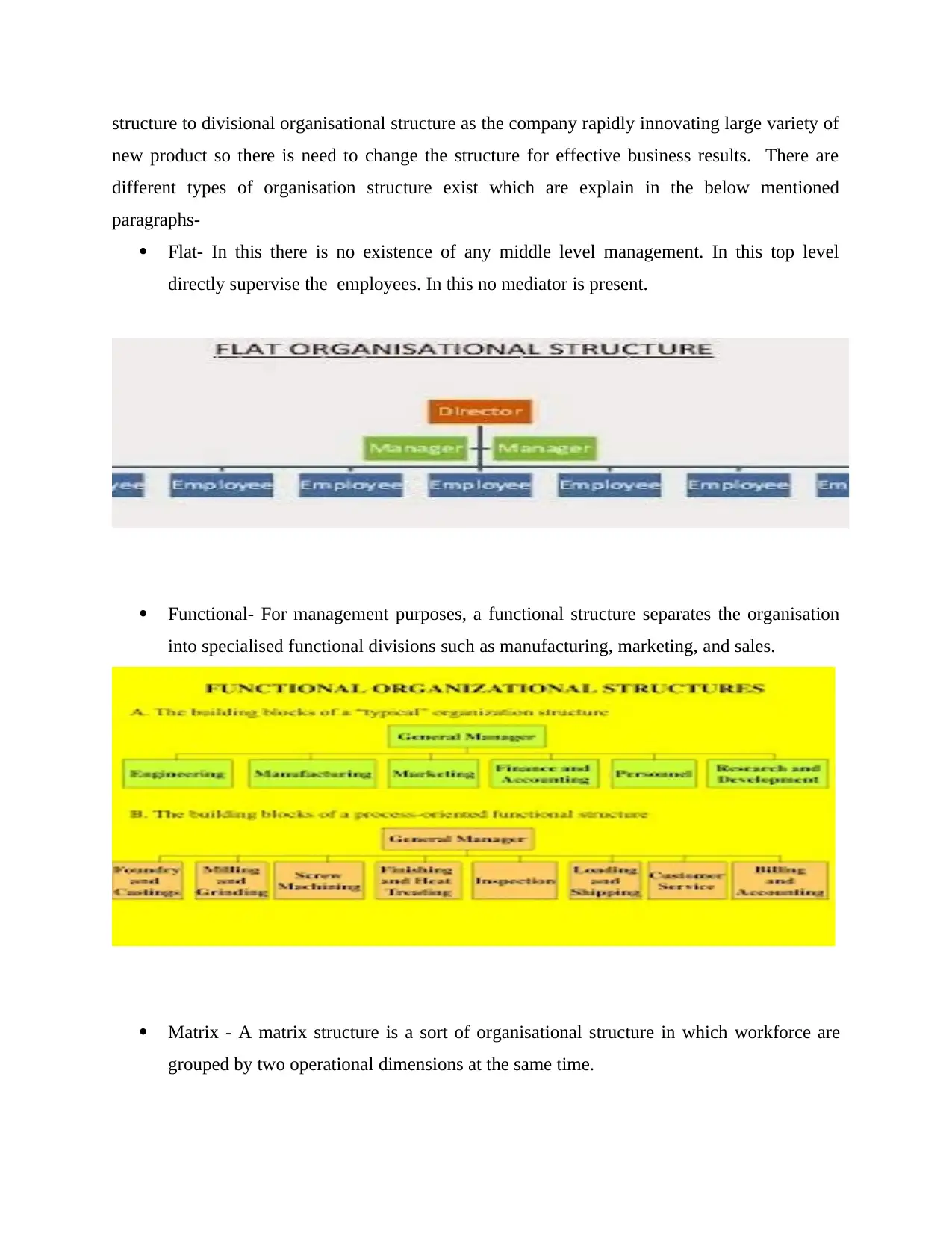
structure to divisional organisational structure as the company rapidly innovating large variety of
new product so there is need to change the structure for effective business results. There are
different types of organisation structure exist which are explain in the below mentioned
paragraphs-
Flat- In this there is no existence of any middle level management. In this top level
directly supervise the employees. In this no mediator is present.
Functional- For management purposes, a functional structure separates the organisation
into specialised functional divisions such as manufacturing, marketing, and sales.
Matrix - A matrix structure is a sort of organisational structure in which workforce are
grouped by two operational dimensions at the same time.
new product so there is need to change the structure for effective business results. There are
different types of organisation structure exist which are explain in the below mentioned
paragraphs-
Flat- In this there is no existence of any middle level management. In this top level
directly supervise the employees. In this no mediator is present.
Functional- For management purposes, a functional structure separates the organisation
into specialised functional divisions such as manufacturing, marketing, and sales.
Matrix - A matrix structure is a sort of organisational structure in which workforce are
grouped by two operational dimensions at the same time.
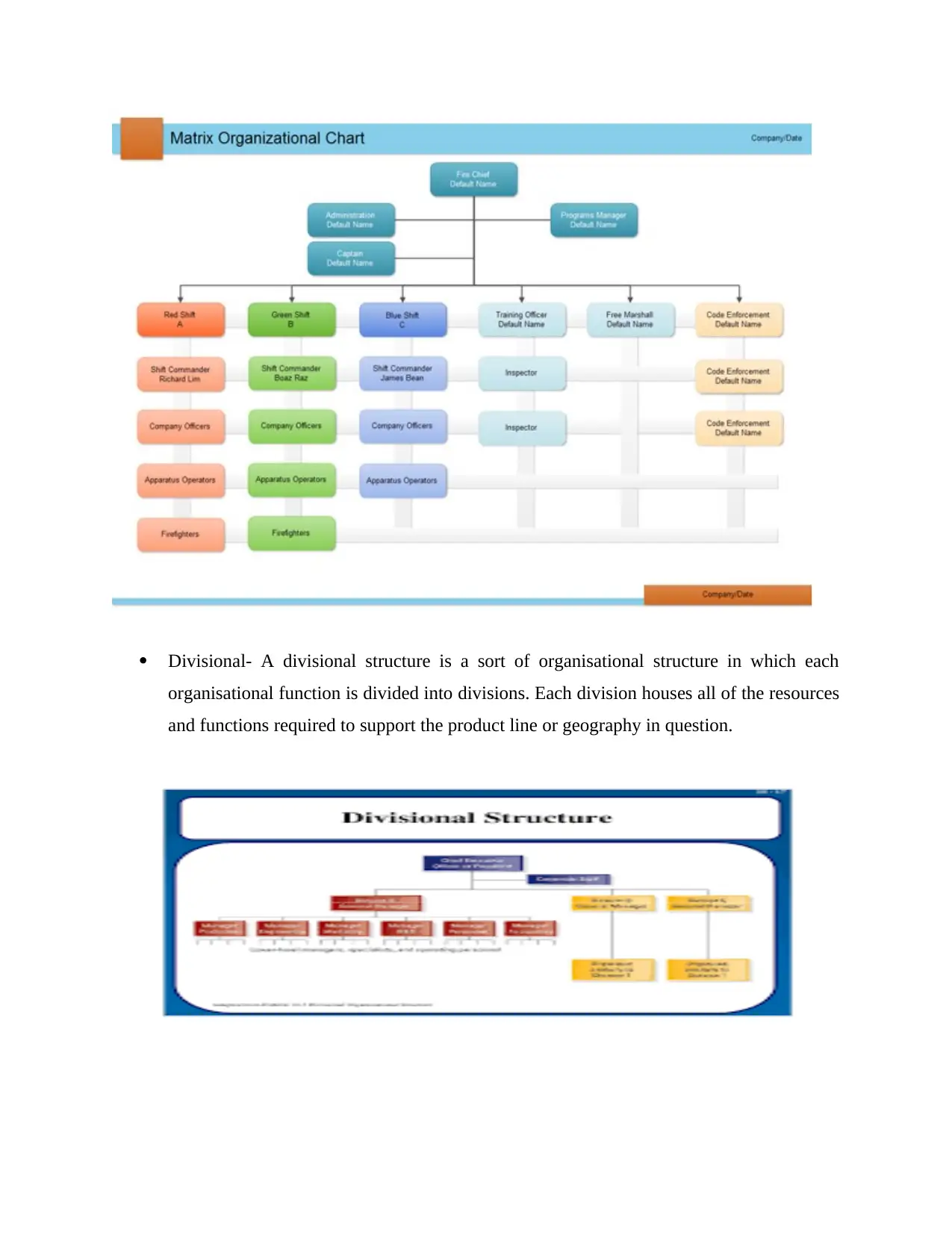
Divisional- A divisional structure is a sort of organisational structure in which each
organisational function is divided into divisions. Each division houses all of the resources
and functions required to support the product line or geography in question.
organisational function is divided into divisions. Each division houses all of the resources
and functions required to support the product line or geography in question.
⊘ This is a preview!⊘
Do you want full access?
Subscribe today to unlock all pages.

Trusted by 1+ million students worldwide
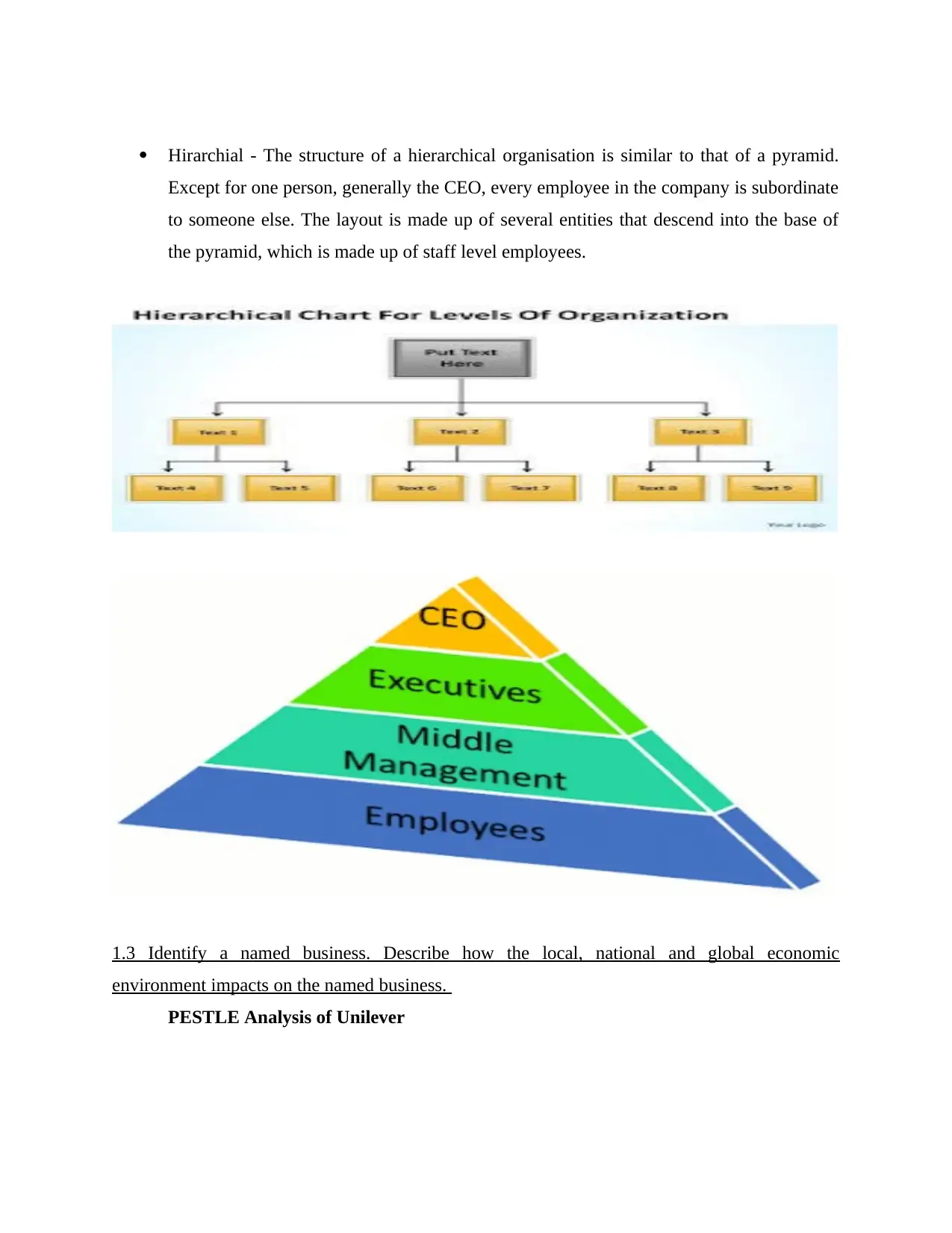
Hirarchial - The structure of a hierarchical organisation is similar to that of a pyramid.
Except for one person, generally the CEO, every employee in the company is subordinate
to someone else. The layout is made up of several entities that descend into the base of
the pyramid, which is made up of staff level employees.
1.3 Identify a named business. Describe how the local, national and global economic
environment impacts on the named business.
PESTLE Analysis of Unilever
Except for one person, generally the CEO, every employee in the company is subordinate
to someone else. The layout is made up of several entities that descend into the base of
the pyramid, which is made up of staff level employees.
1.3 Identify a named business. Describe how the local, national and global economic
environment impacts on the named business.
PESTLE Analysis of Unilever
Paraphrase This Document
Need a fresh take? Get an instant paraphrase of this document with our AI Paraphraser
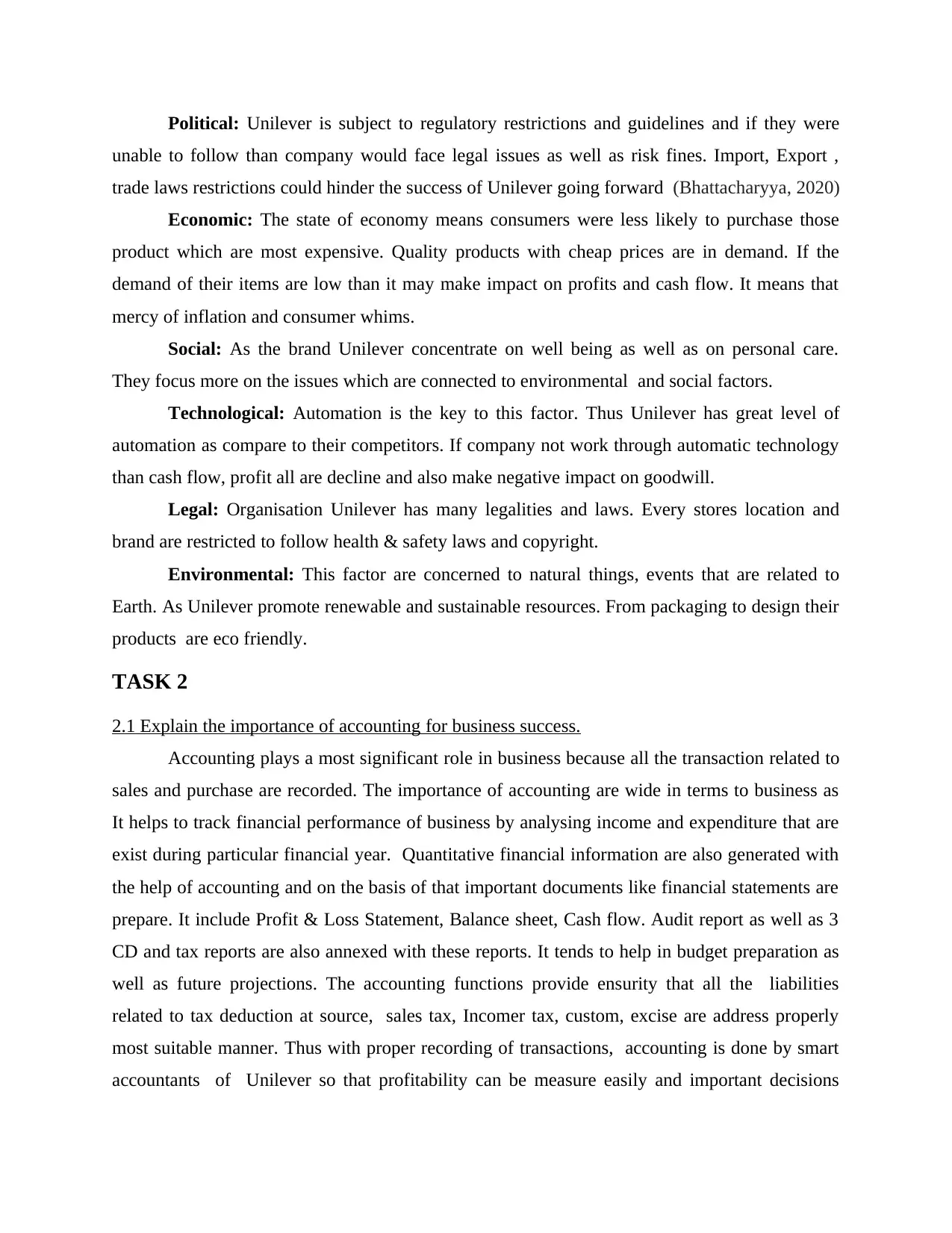
Political: Unilever is subject to regulatory restrictions and guidelines and if they were
unable to follow than company would face legal issues as well as risk fines. Import, Export ,
trade laws restrictions could hinder the success of Unilever going forward (Bhattacharyya, 2020)
Economic: The state of economy means consumers were less likely to purchase those
product which are most expensive. Quality products with cheap prices are in demand. If the
demand of their items are low than it may make impact on profits and cash flow. It means that
mercy of inflation and consumer whims.
Social: As the brand Unilever concentrate on well being as well as on personal care.
They focus more on the issues which are connected to environmental and social factors.
Technological: Automation is the key to this factor. Thus Unilever has great level of
automation as compare to their competitors. If company not work through automatic technology
than cash flow, profit all are decline and also make negative impact on goodwill.
Legal: Organisation Unilever has many legalities and laws. Every stores location and
brand are restricted to follow health & safety laws and copyright.
Environmental: This factor are concerned to natural things, events that are related to
Earth. As Unilever promote renewable and sustainable resources. From packaging to design their
products are eco friendly.
TASK 2
2.1 Explain the importance of accounting for business success.
Accounting plays a most significant role in business because all the transaction related to
sales and purchase are recorded. The importance of accounting are wide in terms to business as
It helps to track financial performance of business by analysing income and expenditure that are
exist during particular financial year. Quantitative financial information are also generated with
the help of accounting and on the basis of that important documents like financial statements are
prepare. It include Profit & Loss Statement, Balance sheet, Cash flow. Audit report as well as 3
CD and tax reports are also annexed with these reports. It tends to help in budget preparation as
well as future projections. The accounting functions provide ensurity that all the liabilities
related to tax deduction at source, sales tax, Incomer tax, custom, excise are address properly
most suitable manner. Thus with proper recording of transactions, accounting is done by smart
accountants of Unilever so that profitability can be measure easily and important decisions
unable to follow than company would face legal issues as well as risk fines. Import, Export ,
trade laws restrictions could hinder the success of Unilever going forward (Bhattacharyya, 2020)
Economic: The state of economy means consumers were less likely to purchase those
product which are most expensive. Quality products with cheap prices are in demand. If the
demand of their items are low than it may make impact on profits and cash flow. It means that
mercy of inflation and consumer whims.
Social: As the brand Unilever concentrate on well being as well as on personal care.
They focus more on the issues which are connected to environmental and social factors.
Technological: Automation is the key to this factor. Thus Unilever has great level of
automation as compare to their competitors. If company not work through automatic technology
than cash flow, profit all are decline and also make negative impact on goodwill.
Legal: Organisation Unilever has many legalities and laws. Every stores location and
brand are restricted to follow health & safety laws and copyright.
Environmental: This factor are concerned to natural things, events that are related to
Earth. As Unilever promote renewable and sustainable resources. From packaging to design their
products are eco friendly.
TASK 2
2.1 Explain the importance of accounting for business success.
Accounting plays a most significant role in business because all the transaction related to
sales and purchase are recorded. The importance of accounting are wide in terms to business as
It helps to track financial performance of business by analysing income and expenditure that are
exist during particular financial year. Quantitative financial information are also generated with
the help of accounting and on the basis of that important documents like financial statements are
prepare. It include Profit & Loss Statement, Balance sheet, Cash flow. Audit report as well as 3
CD and tax reports are also annexed with these reports. It tends to help in budget preparation as
well as future projections. The accounting functions provide ensurity that all the liabilities
related to tax deduction at source, sales tax, Incomer tax, custom, excise are address properly
most suitable manner. Thus with proper recording of transactions, accounting is done by smart
accountants of Unilever so that profitability can be measure easily and important decisions
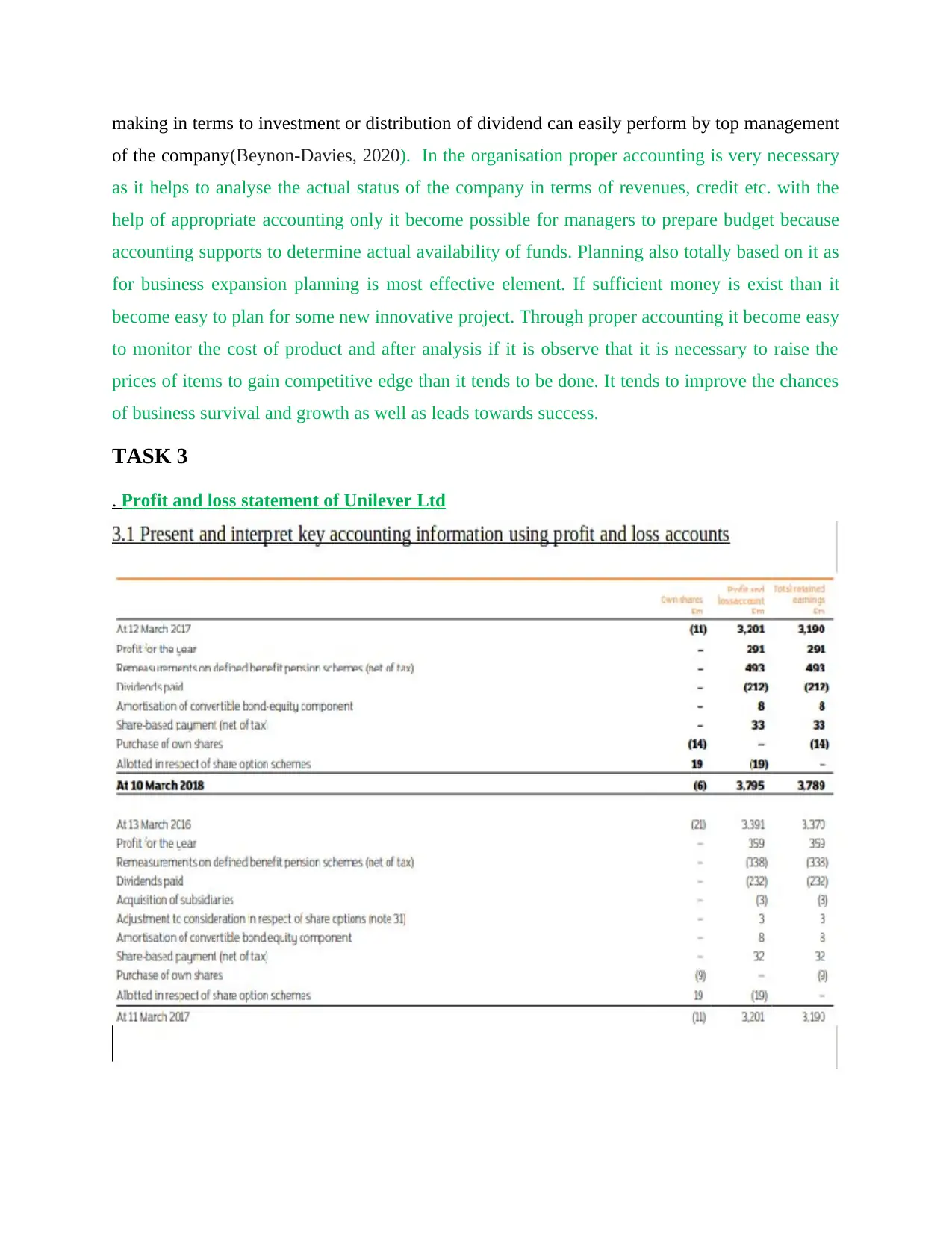
making in terms to investment or distribution of dividend can easily perform by top management
of the company(Beynon-Davies, 2020). In the organisation proper accounting is very necessary
as it helps to analyse the actual status of the company in terms of revenues, credit etc. with the
help of appropriate accounting only it become possible for managers to prepare budget because
accounting supports to determine actual availability of funds. Planning also totally based on it as
for business expansion planning is most effective element. If sufficient money is exist than it
become easy to plan for some new innovative project. Through proper accounting it become easy
to monitor the cost of product and after analysis if it is observe that it is necessary to raise the
prices of items to gain competitive edge than it tends to be done. It tends to improve the chances
of business survival and growth as well as leads towards success.
TASK 3
. Profit and loss statement of Unilever Ltd
of the company(Beynon-Davies, 2020). In the organisation proper accounting is very necessary
as it helps to analyse the actual status of the company in terms of revenues, credit etc. with the
help of appropriate accounting only it become possible for managers to prepare budget because
accounting supports to determine actual availability of funds. Planning also totally based on it as
for business expansion planning is most effective element. If sufficient money is exist than it
become easy to plan for some new innovative project. Through proper accounting it become easy
to monitor the cost of product and after analysis if it is observe that it is necessary to raise the
prices of items to gain competitive edge than it tends to be done. It tends to improve the chances
of business survival and growth as well as leads towards success.
TASK 3
. Profit and loss statement of Unilever Ltd
⊘ This is a preview!⊘
Do you want full access?
Subscribe today to unlock all pages.

Trusted by 1+ million students worldwide
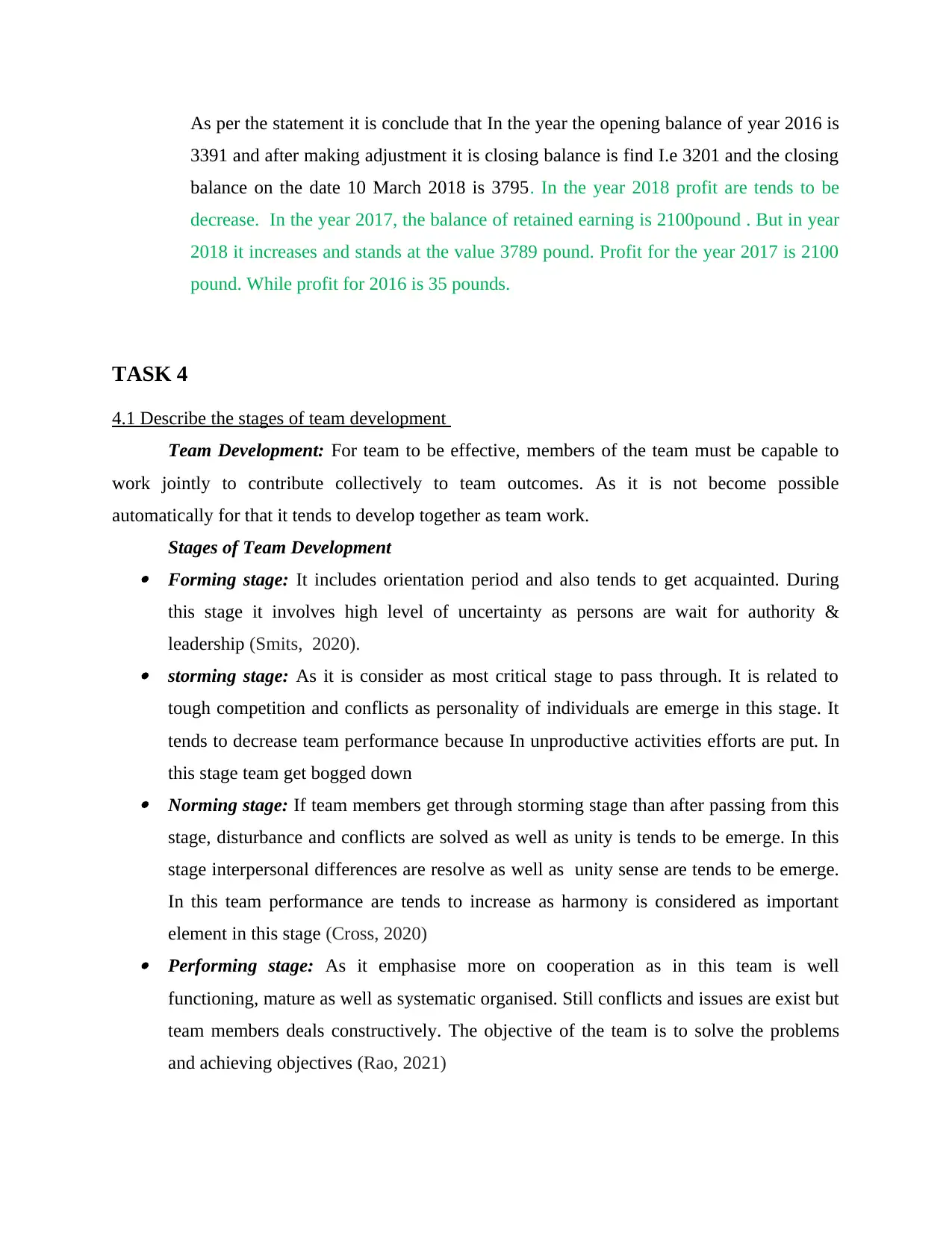
As per the statement it is conclude that In the year the opening balance of year 2016 is
3391 and after making adjustment it is closing balance is find I.e 3201 and the closing
balance on the date 10 March 2018 is 3795. In the year 2018 profit are tends to be
decrease. In the year 2017, the balance of retained earning is 2100pound . But in year
2018 it increases and stands at the value 3789 pound. Profit for the year 2017 is 2100
pound. While profit for 2016 is 35 pounds.
TASK 4
4.1 Describe the stages of team development
Team Development: For team to be effective, members of the team must be capable to
work jointly to contribute collectively to team outcomes. As it is not become possible
automatically for that it tends to develop together as team work.
Stages of Team Development Forming stage: It includes orientation period and also tends to get acquainted. During
this stage it involves high level of uncertainty as persons are wait for authority &
leadership (Smits, 2020). storming stage: As it is consider as most critical stage to pass through. It is related to
tough competition and conflicts as personality of individuals are emerge in this stage. It
tends to decrease team performance because In unproductive activities efforts are put. In
this stage team get bogged down Norming stage: If team members get through storming stage than after passing from this
stage, disturbance and conflicts are solved as well as unity is tends to be emerge. In this
stage interpersonal differences are resolve as well as unity sense are tends to be emerge.
In this team performance are tends to increase as harmony is considered as important
element in this stage (Cross, 2020) Performing stage: As it emphasise more on cooperation as in this team is well
functioning, mature as well as systematic organised. Still conflicts and issues are exist but
team members deals constructively. The objective of the team is to solve the problems
and achieving objectives (Rao, 2021)
3391 and after making adjustment it is closing balance is find I.e 3201 and the closing
balance on the date 10 March 2018 is 3795. In the year 2018 profit are tends to be
decrease. In the year 2017, the balance of retained earning is 2100pound . But in year
2018 it increases and stands at the value 3789 pound. Profit for the year 2017 is 2100
pound. While profit for 2016 is 35 pounds.
TASK 4
4.1 Describe the stages of team development
Team Development: For team to be effective, members of the team must be capable to
work jointly to contribute collectively to team outcomes. As it is not become possible
automatically for that it tends to develop together as team work.
Stages of Team Development Forming stage: It includes orientation period and also tends to get acquainted. During
this stage it involves high level of uncertainty as persons are wait for authority &
leadership (Smits, 2020). storming stage: As it is consider as most critical stage to pass through. It is related to
tough competition and conflicts as personality of individuals are emerge in this stage. It
tends to decrease team performance because In unproductive activities efforts are put. In
this stage team get bogged down Norming stage: If team members get through storming stage than after passing from this
stage, disturbance and conflicts are solved as well as unity is tends to be emerge. In this
stage interpersonal differences are resolve as well as unity sense are tends to be emerge.
In this team performance are tends to increase as harmony is considered as important
element in this stage (Cross, 2020) Performing stage: As it emphasise more on cooperation as in this team is well
functioning, mature as well as systematic organised. Still conflicts and issues are exist but
team members deals constructively. The objective of the team is to solve the problems
and achieving objectives (Rao, 2021)
Paraphrase This Document
Need a fresh take? Get an instant paraphrase of this document with our AI Paraphraser
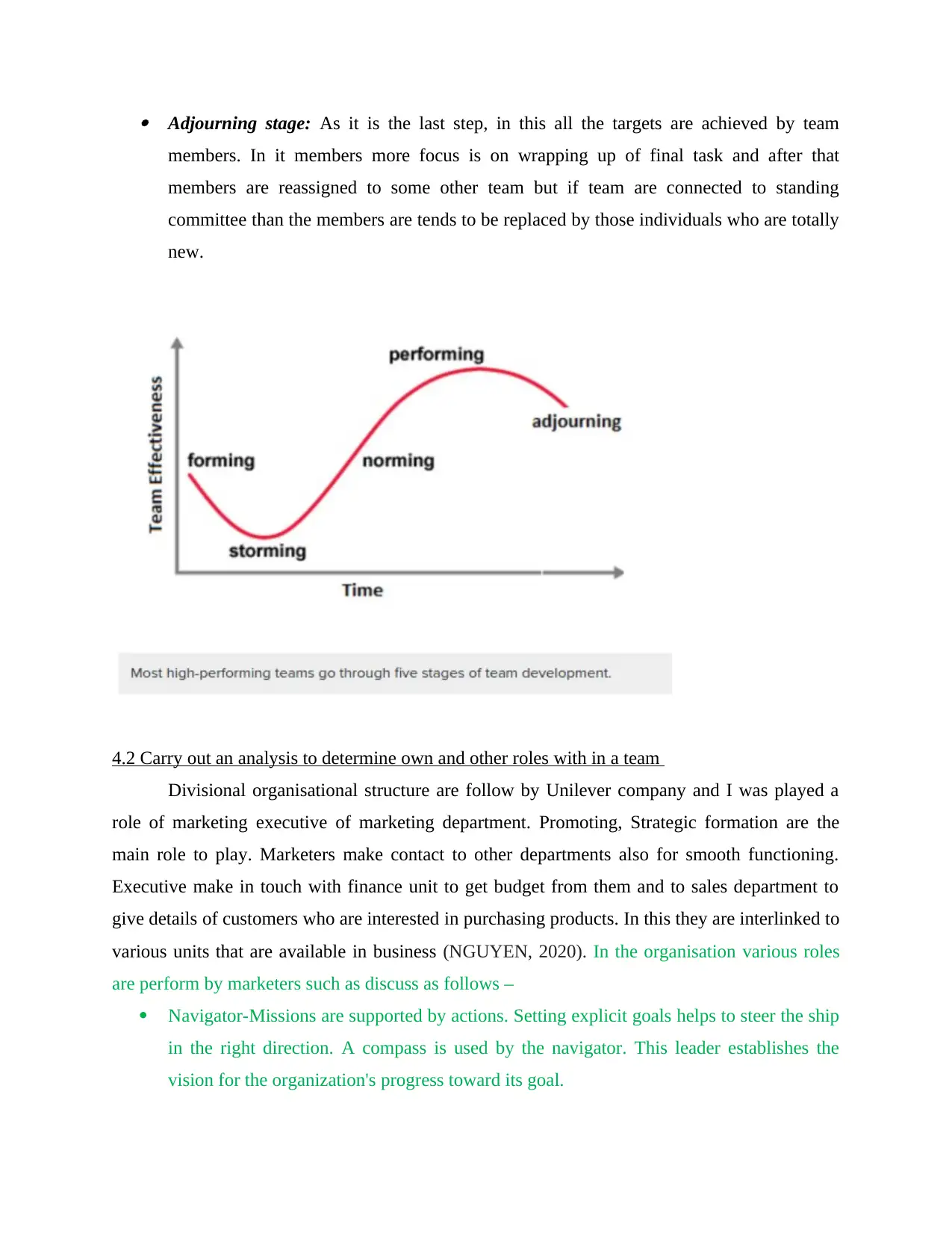
Adjourning stage: As it is the last step, in this all the targets are achieved by team
members. In it members more focus is on wrapping up of final task and after that
members are reassigned to some other team but if team are connected to standing
committee than the members are tends to be replaced by those individuals who are totally
new.
4.2 Carry out an analysis to determine own and other roles with in a team
Divisional organisational structure are follow by Unilever company and I was played a
role of marketing executive of marketing department. Promoting, Strategic formation are the
main role to play. Marketers make contact to other departments also for smooth functioning.
Executive make in touch with finance unit to get budget from them and to sales department to
give details of customers who are interested in purchasing products. In this they are interlinked to
various units that are available in business (NGUYEN, 2020). In the organisation various roles
are perform by marketers such as discuss as follows –
Navigator-Missions are supported by actions. Setting explicit goals helps to steer the ship
in the right direction. A compass is used by the navigator. This leader establishes the
vision for the organization's progress toward its goal.
members. In it members more focus is on wrapping up of final task and after that
members are reassigned to some other team but if team are connected to standing
committee than the members are tends to be replaced by those individuals who are totally
new.
4.2 Carry out an analysis to determine own and other roles with in a team
Divisional organisational structure are follow by Unilever company and I was played a
role of marketing executive of marketing department. Promoting, Strategic formation are the
main role to play. Marketers make contact to other departments also for smooth functioning.
Executive make in touch with finance unit to get budget from them and to sales department to
give details of customers who are interested in purchasing products. In this they are interlinked to
various units that are available in business (NGUYEN, 2020). In the organisation various roles
are perform by marketers such as discuss as follows –
Navigator-Missions are supported by actions. Setting explicit goals helps to steer the ship
in the right direction. A compass is used by the navigator. This leader establishes the
vision for the organization's progress toward its goal.
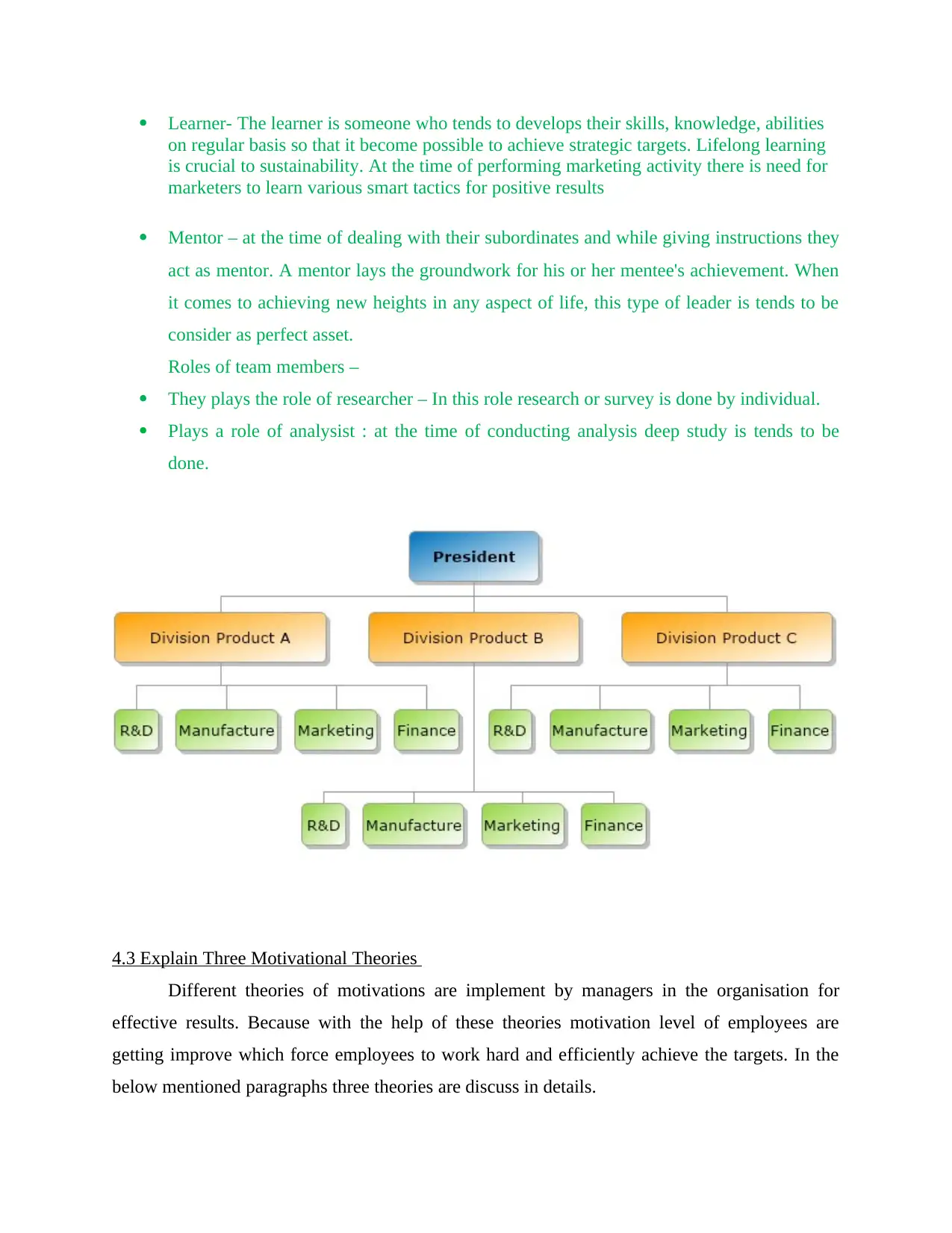
Learner- The learner is someone who tends to develops their skills, knowledge, abilities
on regular basis so that it become possible to achieve strategic targets. Lifelong learning
is crucial to sustainability. At the time of performing marketing activity there is need for
marketers to learn various smart tactics for positive results
Mentor – at the time of dealing with their subordinates and while giving instructions they
act as mentor. A mentor lays the groundwork for his or her mentee's achievement. When
it comes to achieving new heights in any aspect of life, this type of leader is tends to be
consider as perfect asset.
Roles of team members –
They plays the role of researcher – In this role research or survey is done by individual.
Plays a role of analysist : at the time of conducting analysis deep study is tends to be
done.
4.3 Explain Three Motivational Theories
Different theories of motivations are implement by managers in the organisation for
effective results. Because with the help of these theories motivation level of employees are
getting improve which force employees to work hard and efficiently achieve the targets. In the
below mentioned paragraphs three theories are discuss in details.
on regular basis so that it become possible to achieve strategic targets. Lifelong learning
is crucial to sustainability. At the time of performing marketing activity there is need for
marketers to learn various smart tactics for positive results
Mentor – at the time of dealing with their subordinates and while giving instructions they
act as mentor. A mentor lays the groundwork for his or her mentee's achievement. When
it comes to achieving new heights in any aspect of life, this type of leader is tends to be
consider as perfect asset.
Roles of team members –
They plays the role of researcher – In this role research or survey is done by individual.
Plays a role of analysist : at the time of conducting analysis deep study is tends to be
done.
4.3 Explain Three Motivational Theories
Different theories of motivations are implement by managers in the organisation for
effective results. Because with the help of these theories motivation level of employees are
getting improve which force employees to work hard and efficiently achieve the targets. In the
below mentioned paragraphs three theories are discuss in details.
⊘ This is a preview!⊘
Do you want full access?
Subscribe today to unlock all pages.

Trusted by 1+ million students worldwide
1 out of 18
Related Documents
Your All-in-One AI-Powered Toolkit for Academic Success.
+13062052269
info@desklib.com
Available 24*7 on WhatsApp / Email
![[object Object]](/_next/static/media/star-bottom.7253800d.svg)
Unlock your academic potential
Copyright © 2020–2025 A2Z Services. All Rights Reserved. Developed and managed by ZUCOL.





